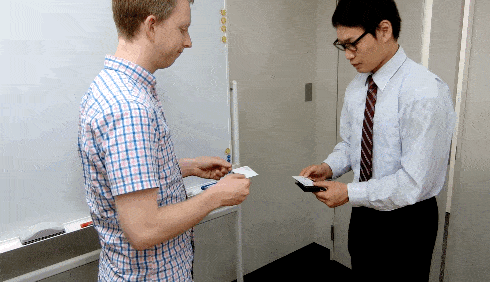Interesting
11 Japanese Etiquette That You Need to Know When in Japan
Japan and its people are known for a lot of things – from anime to out of this world fashion to their love towards exotic food. Apparently, the country is also famous for its rather complex etiquette rules. For instance, they love to celebrate and make a ceremony out of simple actions when it seems unnecessary. Nonetheless, no one is offended by it.
We here at Elite Readers have managed to compile all courtesy rules straight from the Land of the Rising Sun. Check them out and see for yourself.
#11. The Way They Address People
This is common knowledge, though. Japanese address people not simply through names. They actually have honorific suffixes when it comes to addressing and/or referring other individuals. See below:
-
“-kun”— a less formal honorific than the neutral “-san.” General use of “-kun” approximately means “friend.”
-
“-chan” — a diminutive suffix, primarily used for children, female family members, lovers, and close friends.
-
“-sama” — the most respectful version (“lord,” “honorable”). Used to refer to lords and deities.
-
“-senpai” — for addressing one’s elder colleagues or schoolmates.
-
“-kōhai” — the opposite of “senpai.”
-
“-sensei” — for addressing teachers, doctors, scientists, politicians, and other authority figures.
-
“-shi” — for formal writing.
#10. Exchange of Business Cards
This thing is in fact a form of ritual in Japan. However, there are things that you need to consider before exchanging business cards with other people. One, you have to make sure that your card’s front side is facing your counterpart. Second, you must offer it with both hands. Third, if your rank is lower than that of your partner’s, then you better lower your head when you offer it. In Western civilization, people are contented by just putting their cards in their pockets.
#9. When in an Elevator
If you are to enter the elevator first, you are automatically the captain. Hence you must stand close to the control panel. You even have to hold the door open until everyone enters the elevator. And remember: you will have to do this in each floor. More importantly, you must be the last one to leave before you can even choose your floor.
#8. In Subways
Japanese also follow restrictive rules when in subways. For one, staring at others is considered impolite. You are not also allowed to use your phone and thus you must turn it or keep it silent. Apparently, though, you are not obliged to give your seat to elderly people. That is because there are specially-marked seats meant for them as well as for pregnant women and disabled individuals.
#7. Touching
If it is rude to stare at other people in Japan, it is also rude to touch them. Japanese give so much importance in privacy, something that they significantly respect. And, oh, kissing publicly is also frowned upon in Japan.
#6. Alcoholic Drinks
When Japanese people drink, they drink really hard. This eventually leads to the social hierarchy breaking down. However, they have a common courtesy that they follow. For example: If a professor decides to drink with his students, it is his responsibility to guide them home. Interestingly, they can still act normal even after drinking heavily.
#5. Money
Yes, the people in Japan have a very odd attitude when it comes to money. For unknown reason, they feel embarrassed when they show it in public. This is why there are various envelopes decorated in a traditional manner – and these are very popular in the country. If you do not have this envelope, you can wrap the money in a piece of paper before giving it away. Also, if you go to a supermarket, you cannot just hand the money to the cashier. They have cash trays where you can place it.
#4. The Art of Sitting
In the country, they consider sitting an art. There is even a proper way of doing it. If you sit by folding one of your legs underneath your thighs, it is called “seiza.” And for the Japanese, this is the only proper way to sit. Interestingly, if you are a tourist in the country, you can get away with it. The Japanese understand that people outside their country are not comfortable with “seiza.”
#3. Gifts
The culture of giving presents in Japan is quite strong. In fact, they have 2 special gift-giving seasons every year. These are o-chugen (in summer) and o-seibo (in winter). In other countries, people are accustomed to opening gifts all at once. In the Land of the Rising Sun, however, it is not. They deem it as a sign of greed and impatience.
#2. Bowing
Just like exchanging business cards, bowing is also an art for the Japanese. They even teach their kids how to bow the right way at a very young age. Apparently, there are various ways to bow in Japan. These are standing, sitting, and female and male variants. Check them out below:
-
The greeting bow (“eshaku“) of 15° is for people of equal business or social rank.
-
The respectful bow (”keirei“) of 30° is a bow for a teacher or a boss.
-
The deeply reverent bow (“saikeirei”) of 45° should be used if you apologize or see the emperor.
-
The ”begging for your life” bow is probably only used nowadays if you have done something really terrible.
#1. Taking Leave
In Japan, a customer or even a business partner is deemed almost a god. They are treated with utmost respect. Hence when they leave, the whole company tends to follow them to the door or elevator. And believe it or not, they keep bowing until the doors are closed. You would often see this in business centers.

-
OMG6 years ago
Man Iced Neighbor Who Repeatedly Asked Him “When Are You Getting Married?”
-
Interesting7 years ago
The Secret Meaning of Anklets And Why Some Wives Wear Them
-
Interesting7 years ago
Waking Up Between 3 to 5 AM Could Mean You’re Experiencing Spiritual Awakening
-
Interesting6 years ago
Pork Fat Is Officially One of the World’s Most Nutritious Foods









































